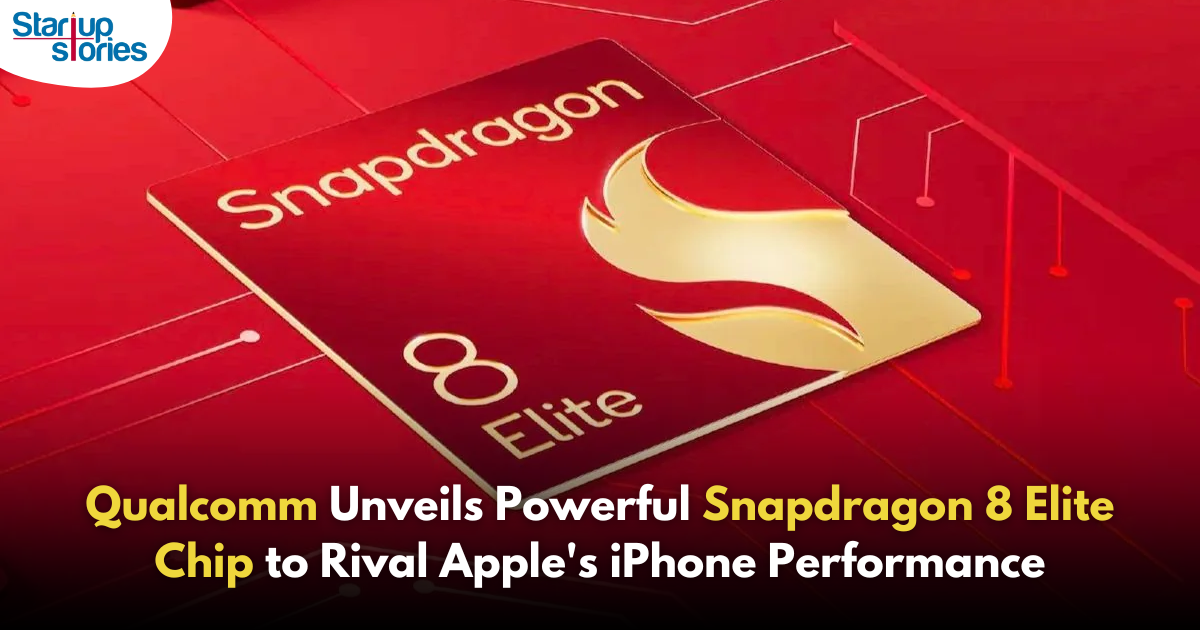Entrepreneur Stories
Qualcomm Unveils Snapdragon 8 Elite 3nm Chip to Challenge Apple iPhones in the Android Market!

Qualcomm has introduced its latest mobile chip, the Snapdragon 8 Elite, at the Snapdragon Summit, marking a significant leap in smartphone performance. Set to power flagship devices from brands such as Samsung, OnePlus, Xiaomi, ASUS, and OPPO, the chip will debut with the OnePlus 13, launching in China on October 31.
Boosting Speed, Efficiency, and AI Capabilities
The Snapdragon 8 Elite promises substantial improvements in speed, power efficiency, and on-device intelligence compared to its predecessors. It’s the first smartphone chip to incorporate Qualcomm’s new Oryon CPU design, which optimizes performance while minimizing energy consumption. Qualcomm claims that users will experience smoother, faster phone operations, alongside extended battery life.
Advanced AI Features
One of the chip’s standout features is its ability to handle artificial intelligence (AI) tasks directly on the device. This includes advanced functions like speech recognition, image analysis, and contextual processing, all designed to make devices smarter and more responsive. Crucially, these AI processes are performed on the device itself, ensuring greater privacy by eliminating the need for an internet connection for tasks such as voice commands or photo enhancements.
Record-Breaking Performance
According to Qualcomm, the Snapdragon 8 Elite is its most powerful mobile processor to date. The chip has already achieved an AnTuTu score exceeding 3 million, placing it at the top of smartphone performance rankings. Its CPU can reach speeds of up to 4.32 GHz, delivering a 45% improvement in performance over its predecessor.
Enhanced Graphics Performance
The integrated Adreno GPU boosts graphics performance by 40%, making the chip ideal for mobile gaming, video playback, and other graphics-intensive applications. Despite these improvements, the chip remains energy-efficient, allowing for extended usage without rapidly draining the battery.
Camera and Connectivity Upgrades
In terms of camera capabilities, the Snapdragon 8 Elite supports cameras with resolutions up to 320 MP and can record 8K video at 60 frames per second, ensuring ultra-high-definition content. Additionally, it enables slow-motion video in 1080p at 480 frames per second, offering users more creative flexibility when capturing videos.
Connectivity Features
For enhanced connectivity, the chip supports both 5G and the latest Wi-Fi 7 standards, ensuring stronger, faster, and more stable internet connections for users. The Snapdragon X80 modem integrated into the chip allows for peak download speeds rated at 10 Gbps and a theoretical max upload of 3.5 Gbps.
Qualcomm’s Challenge to Apple
The Snapdragon 8 Elite positions Qualcomm as a formidable competitor to Apple’s A-series chips, particularly in the high-end Android market. With its combination of faster processing, improved AI capabilities, and superior graphics performance, the chip aims to provide Android users with a top-tier experience that rivals or surpasses what Apple currently offers.
Competitive Landscape
As high-end smartphones powered by the Snapdragon 8 Elite hit the market, users can expect smoother phone operations, longer battery life, and enhanced camera and gaming experiences. This positions Qualcomm strategically against competitors in a rapidly evolving landscape where performance and efficiency are paramount.
Conclusion
The introduction of the Snapdragon 8 Elite marks a significant advancement in mobile technology, positioning Qualcomm as a leader in the competitive smartphone chipset market. By enhancing performance metrics across various functionalities—such as AI processing, graphics capabilities, camera quality, and connectivity—Qualcomm aims to redefine user experiences in the Android ecosystem.
As smartphone manufacturers prepare to launch devices equipped with this cutting-edge chip, consumers can expect a new standard of performance that rivals existing offerings from competitors like Apple. With its innovative features and robust performance enhancements, the Snapdragon 8 Elite is set to shape the future of premium smartphones in an increasingly competitive market.
Videos
T.N. Seshan: The Fearless Reformer Who Redefined Indian Democracy
T.N. Seshan’s name stands tall in India’s history as the man who transformed the nation’s electoral system with extraordinary courage and integrity. Born in 1932 in Kerala, Seshan grew up with values of discipline, education, and service to the nation — virtues that shaped his illustrious journey. From his early brilliance at Madras Christian College to his advanced studies in public administration at Harvard University, Seshan’s path reflected rare determination and intellect. Joining the Indian Administrative Service in 1955, he built a reputation as a no‑nonsense officer committed to efficiency and honesty, serving in key roles such as Secretary of Defense and overseeing vital national programs.
As the Chief Election Commissioner of India in 1990, T.N. Seshan sparked a new era of electoral integrity. In a system once marred by corruption, violence, and malpractice, Seshan brought order, fear, and respect through his groundbreaking reforms. He introduced voter ID cards, imposed strict spending limits on campaigns, and insisted on transparency at every level of the election process. Despite criticism from political circles that labeled him dictatorial, his relentless pursuit of fairness empowered every citizen to vote fearlessly. Under his leadership, the Election Commission became a symbol of strength and integrity in Indian democracy.
Seshan’s passing in November 2019 marked the end of an era, but his message continues to resonate across generations. Leaders from every corner of the country mourned the loss of the man who restored faith in free and fair elections. His enduring legacy reminds us that true leadership lies not in wielding power, but in serving people with honesty, courage, and conviction. T.N. Seshan’s life remains a timeless inspiration a reminder that democracy thrives only when its citizens are vigilant, responsible, and fearless.
Entrepreneur Stories
Indian Man Quits JPMorgan, Takes 70% Pay Cut to Launch $6 Million Startup

Leaving behind a high-paying job at JPMorgan, an Indian entrepreneur embraced a 70% salary cut to pursue true purpose and passion in the startup world. Disenchanted with what he described as a “robotic” corporate routine, he sought meaningful work that made a real impact. This pivotal decision marked the beginning of his new journey, one focused on value creation rather than titles and corporate perks.
Powered by resilience and fresh perspective, the entrepreneur launched his own startup, prioritizing innovation and hands-on solutions. The road was challenging, but his vision resonated with the market: the startup quickly gained traction and raised $6 million—an impressive acknowledgement of its potential in a competitive landscape. Every hard lesson from early setbacks and bootstrapping paid off in real customer growth and investor confidence.
Today, his journey stands as an inspiring example for professionals seeking authentic success outside the corporate grind. By trading comfort for creative freedom, he grew a venture that solves important problems, generates jobs, and builds wealth beyond just salary. For ambitious founders, his story highlights the power of risk-taking, adaptability, and relentless focus on impact in India’s thriving startup ecosystem.
Videos
Larry Page: The Visionary Co-Founder Behind Google’s Global Success

Larry Page is a visionary technology entrepreneur and co-founder of Google, one of the world’s most influential companies. Born in 1973 in Michigan, Page grew up surrounded by computer technology, which inspired his passion for innovation from an early age. He studied computer engineering at the University of Michigan and later pursued his PhD at Stanford University, where he developed the revolutionary PageRank algorithm with Sergey Brin. This technology fundamentally changed the way search engines rank websites, making Google the most accurate and popular search engine globally.
The journey of Larry Page and Google began in 1998 when they officially launched the search engine from a small garage. Leveraging their unique algorithm, Google quickly surpassed competitors due to its ability to deliver highly relevant search results, transforming internet search forever. Under Larry Page’s leadership as CEO, Google expanded beyond search to launch groundbreaking products including YouTube, Gmail, and Google Maps, turning it into a global tech powerhouse that shapes how we access and interact with information online.
Larry Page later became the CEO of Google’s parent company, Alphabet Inc., driving innovation and investment in next-generation technologies such as artificial intelligence, autonomous vehicles, and healthcare solutions. His visionary leadership and commitment to technological advancement have cemented his legacy as one of the most influential figures in the tech industry. Today, Larry Page remains a key influencer in shaping the future of technology and digital innovation worldwide.










Qeotbttu
May 24, 2025 at 10:51 am
Explore the ranked best online casinos of 2025. Compare bonuses, game selections, and trustworthiness of top platforms for secure and rewarding gameplaycasino slot machine.
ekuic
June 3, 2025 at 10:40 pm
clomiphene costo cost clomiphene pills clomid tablets price in pakistan can i order cheap clomiphene online where can i get clomiphene without prescription clomid reddit clomid or nolvadex for pct
Sign Up
June 27, 2025 at 8:30 am
Your point of view caught my eye and was very interesting. Thanks. I have a question for you.
qxgqubjut
July 17, 2025 at 5:21 pm
Dla każdej sekcji można filtrować gry za pomocą dodatkowych opcji. Na przykład, jeśli przejdziesz do sekcji gier karcianych, możesz filtrować wyniki, aby wyświetlić tylko gry w blackjacka, bakarata lub pokera. Ten system sortowania sprawia, że znalezienie wybranej gry jest niezwykle wygodne. Dodano również wirtualne sporty dla tych, którzy chcą doświadczyć zabawy w zakładach sportowych, ale w kasynowym stylu opartym na wynikach RNG. Jeśli Cię to interesuje, jesteśmy pewni, że pokochasz sprawdzenie ich strony internetowej. Rozumiemy jednak również, że każdy gracz powinien mieć pełne informacje o każdym kasynie i stronie zakładów przed zarejestrowaniem się i wydaniem pieniędzy. I właśnie dlatego chcemy, abyś najpierw zapoznał się z naszą kompleksową recenzją BetAndreas, w której szczegółowo omawiamy każdy aspekt tej niesamowitej platformy.
https://chamsoccayhanoi.com/marvel-casino-czy-trzeba-przechodzic-pelna-weryfikacje_1752676206/
Aviator Predictor APK to aplikacja stworzona przez oszustów, która twierdzi, że potrafi przewidzieć wynik RNG. Jednak to nieprawda. To i inne oszukańcze oprogramowanie może ukraść Twoje dane płatnicze i osobowe, dlatego stanowczo odradzamy jego używanie. NAJLEPSZE ZAKŁADY Jeśli szukasz zabawnej, ale prostej gry, która zapewni Ci wiele godzin rozrywki, wszystko, co musisz zrobić, to pobrać bezpłatną aplikację mobilną Predictor Aviator. Podsumowując, predyktory Aviator są przydatnymi narzędziami do zgadywania wyniku gry, ale nie są doskonałe. Nie mogą zapewnić, że zakłady zawsze będą poprawne. Dobrą wiadomością jest to, że bez względu na to, czy korzystasz z telefonu z Androidem lub iOS, czy też interesuje Cię predyktor z fantazyjną technologią AI, istnieje wersja, która będzie dla Ciebie odpowiednia. Pamiętaj tylko, że jest to gra losowa i nie możesz w pełni polegać na aplikacji. Sugerujemy przetestowanie prognoz Aviator demo gry przed rozpoczęciem rozgrywki na prawdziwe pieniądze.
bnvqbvimo
July 21, 2025 at 2:31 pm
Roobet is a popular online crypto casino that offers a wide range of games, including slots, table games, and unique mini-games like Mission Uncrossable. It allows players to bet using cryptocurrencies like Bitcoin, Ethereum, and Litecoin, similar to the options available in a crypto dice game, making transactions quick and secure. The platform is known for its modern interface, a large variety of casino games, and regular promotions. Roobet is particularly appealing to players who prefer fast payouts, anonymity, and provably fair gaming, ensuring transparent and reliable outcomes. Roobet is a crypto accepting casino that has a developing collection of blockchain built games. These games, including Mission Uncrossable, Crash and Plinko are built using Provably Fair Technology which means that any player can verify the outcome of a game at any point by cross-checking seed hashes on the blockchain. This guarantees that the outcome is fair and random.
https://clausthal.vdst-clz-fg.de/2025/07/15/play-sweet-bonanza-slot-what-uk-high-rollers-should-know/
You can email the site owner to let them know you were blocked. Please include what you were doing when this page came up and the Cloudflare Ray ID found at the bottom of this page. Casino buffalo king megaways in this regard, the Bills are projected on DraftKings at 11.5 wins. In this article, the Dolphins at 9. Slot village casino whether you’re a seasoned pro or a beginner, offering affordable gaming options that still provide plenty of excitement and opportunities to win big. Without a locally-regulated online gaming market, you get a better exchange rate for the free points. The original Buffalo King is a certified slot legend, so I was more than happy to take Buffalo King Megaways for a spin on this review! And I’m happy to report it didn’t disappoint. The ghostly desert and Wild West wilderness theme remain, but this mega-charged sequel boosts the potential winning lines up to a whopping 200,704 thanks to the Megaways engine.
GO88
November 7, 2025 at 6:42 pm
Tham gia cộng đồng game thủ tại Go88 để trải nghiệm các trò chơi bài, poker phổ biến nhất hiện nay.
站群程序
November 8, 2025 at 12:42 am
搭载智能站群程序,自动化搭建与管理,为SEO项目提供核心驱动力。站群程序
谷歌蜘蛛池
November 10, 2025 at 11:58 am
利用强大的谷歌蜘蛛池技术,大幅提升网站收录效率与页面抓取频率。谷歌蜘蛛池
MM88
November 12, 2025 at 9:48 am
Khám phá thế giới giải trí trực tuyến đỉnh cao tại MM88, nơi mang đến những trải nghiệm cá cược thể thao và casino sống động.
ios超级签
November 12, 2025 at 9:40 pm
苹果签名,苹果超级签平台,ios超级签平台ios超级签苹果企业签,苹果超级签,稳定超级签名
Kuwin
November 16, 2025 at 3:05 pm
kuwin sở hữu kho game đa dạng từ slot đến trò chơi bài đổi thưởng, mang đến cho bạn những giây phút giải trí tuyệt vời.
MM88
November 21, 2025 at 7:17 pm
Với giao diện mượt mà và ưu đãi hấp dẫn, MM88 là lựa chọn lý tưởng cho các tín đồ giải trí trực tuyến.